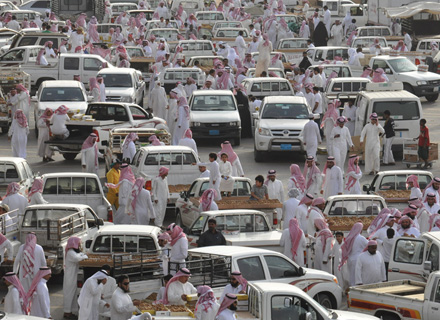The Kingdom of Saudi Arabia has recognised economic diversification as an important contributor for building sustainable economic growth. ITs decision to lead economic diversification is largely attributed to the high dependence on oil which has demonstrated volatility risks on the back of macroeconomic factors in global markets.
Last year, the Kingdom’s GDP growth slowed as a result of tumbling oil production and below average oil prices. In the third quarter, its economy contracted 0.46 percent from the previous year. Although crude is still important to the Kingdom its economic diversification is led by the Vision 2030 programme, a reform responsible for massive developments in select non-oil sectors to create a post-oil future.
What does Saudi Arabia’s post-oil future look like?
The government is expecting real GDP growth in 2020. In fact, the Institute of International Finance in its report noted that the Kingdom’s non-oil economy will remain at 2.7 percent in 2020, largely supported by recovery in private sector economic activity. In January, the International Monetary Authority predicted that the economy would expand 1.9 percent this year, with an increase from an estimated 0.4 percent in 2019. However, the slowdown in oil output has forced the authority to revise the forecast for the Kingdom’s growth to 2.2 percent.
The Kingdom’s non-oil sector is anticipated to grow this year despite the global macroeconomic challenges and mixed forecasts. The good news is that its monetary, fiscal and structural policies are directed toward economic expansion of the private non-oil sector in the medium term.
Interestingly, the IFF report highlights that the Kingdom is in a good position to balance its fiscal budget by 2023 and is now more secure than a few months ago. This is mainly due to the government’s restrained spending amid low oil prices
The credit for the breakthrough goes to the Crown Prince Mohammad Bin Salman Al Saud, who has prepared the ground for the Kingdom’s diversification plan very well. Recently, the Saudi government even introduced a 5 percent value added tax, as part of the diversification plan, to increase revenue and reduce fiscal deficits driven by low oil prices. This is a landmark move ending decades of tax-free living for residents and most businesses in the Kingdom, with exceptions to health, education and public transport.
Tourism is a lynch pin of Saudi Arabia’s diversification plan
The Kingdom is heavily investing in the tourism industry which seeks to contribute from 3 percent to 10 percent GDP by 2030. In essence, its tourism strategy is a major part of the Vision 2030 — and now it has set ambitious targets to become a global tourist destination with grand infrastructure developments and ease of visa restrictions.
Saudi Arabia’s way of enhancing the tourism industry is through development of posh projects which will allow tourists to experience world-class luxury. An example of that is the landmark Red Sea Project which is a land and property development planned along the Kingdom’s Red Sea coast.
Led by the Red Sea Development Company, the mega project is expected to increase the domestic GDP by $5.86 billion annually after completion. The first phase of the project is slated for completion by 2022, with 3,000 suites constructed in addition to an airport, marina and recreation centres.
Every year, the Red Sea Project will attract one million tourists and create 70,000 new jobs. The project’s value addition to job creation is extremely significant as unemployment among Saudi nationals is quite high. In 2018, Saudi youth saw a 25 percent unemployment rate, observed the Federal Reserve Bank of St. Louis.
Another highlight of the project that will lure tourists is its ecological contributions like achieving 100 percent carbon neutrality and no discharges to the sea. Such benefits accrue to both the tourists and the Kingdom, which is seeking to generate revenues that can replace income previously generated from oil production, creating a sustainable form of economic development.
It is no surprise that the Kingdom wants to become a top five global tourism destination over the next decade. The outlook is quite positive for the industry because and it is expected to generate substantial income for the Kingdom.
Real estate projects to contribute to 10% of non-oil economy
Saudi Arabia is planning to create an inflow of hundreds of billions of dollars in public and private investment for infrastructure development which in turn is anticipated to create pronounced opportunities for real estate development.
Recent trends in real estate across Saudi Arabia make it an ideal sector to support diversification plans. The current focus of the sector’s authorities is to increase home ownership and create a conducive environment for foreign and domestic investors.
One of critical projects is by Raza, a subsidiary of Al Ra’idah and a part of the Saudi Public Pension Agency’s real estate management arm, which is focusing on massive commercial developments in Riyadh, Jeddah, and Dammam. Last May, it established a sophisticated real estate management platform offering property management services. It has even launched a five-year strategy for multi-faceted developments integrating both commercial and residential properties in the Kingdom.
The fact is that the government is planning to increase Saudi nationals’ homeownership to 60 percent by 2020 and 70 percent by 2030, with a plan to build 19,500 residential units under the Sakani housing development programme. This in turn will increase the transaction volumes in industry contributing 10 percent to the national non-oil economy by the end of 2020. In line with Vision 2030, the Kingdom’s real estate industry is undergoing a transformational change.
Entertainment sector has the potential to bloom
The entertainment industry is also anticipated to generate $20 billion for the national economy over the next 15 years. With that, it could create approximately 30,000 jobs directly and more than 100,000 indirectly in the Kingdom.
In an attempt to reform the industry, Saudi authorities lifted a decades-old ban on cinemas and nearly 300 are expected to open by 2030. But that’s not all. Other forms of entertainment like comic con and mixed-gender national day celebrations are allowed — in a way, enabling tourists to enjoy their time spent in the Kingdom.
Recently, a Global Economic Conditions Survey published by the Association of Chartered Certified Accountants and the Institute of Management Accountants showed a growth rebound from non-oil sectors in the Middle Eastern economies. The survey notes that reforms in the tourism and entertainment sectors in the Kingdom are expected to boost the national economy.
Public Investment Fund has a key role to play in diversification
Economists anticipate the Kingdom’s investments into non-oil projects directed by the Public Investment Fund to further accelerate the rate of economic activity in 2020.
The sovereign fund’s investments are strategically placed in six key areas, such as Saudi equity holdings, real estate and infrastructure, mega projects and international investments. In fact, its efforts have paid off with international investments accounting for 15 percent of its assets under management last year from 2 percent in 2015.
It provides great support for mega projects by being an anchor investor; for example, in the $500 billion NEOM economic zone. In another example, several new companies focused on as mortgage refinancing, entertainment, ecommerce, waste management, private aviation and fund of funds have been established with the help of Public Investment Fund.
According to a Mckinsey report, the Kingdom has potential to double its non-oil economic growth and create as many as six million new jobs by 2030. For that to happen, the report said that it is important to have nearly $4 trillion in investment. It appears that funds have already been raised for the Kingdom’s investment programme, which is powering economic diversity.
Impact of weak oil market to turbo charge diversification
The pressure of declining oil prices has had an impact on the Kingdom. In 2015, its fiscal deficit had nearly reached $100 billion or 15 percent of GDP. More recently, the Kingdom is set to increase oil production and sell the crude at significantly discounted prices on the back of declining oil demand. This decision has affected not only its domestic oil market but hurt its neighbouring oil producers who are now forced to sell their crude at the price fixed by the Kingdom. Another significant impact on the Kingdom is that its oil dependence has resulted in economic inefficiencies such as increasing unemployment among Saudi nationals.
The Economist Intelligence Unit, a research division of the Economist Group, had expected the deficit to average 10 percent of GDP between 2016 and 2020 as slash in economic spending failed to offset declining oil prices. The International Monetary Fund (IFM) had also predicted the general government gross debt to increase from 5.8 percent of GDP in 2015 to 51 percent of GDP by 2021.
The question now is whether the Saudi government’s efforts to build a non-oil economy will see growth as anticipated.
Last year, the ICAEW and Oxford Economics published Economic Insight: Middle East Q1 2019 which recorded data on government initiatives and budget spending aimed at accelerating non-oil economic expansion. The report noted that the Kingdom is on the right path of transition under the Vision 2030. Higher state spending requires economic growth to increase by 7 percent to drive the diversification plans in the future.
According to the General Authority of Statistics, a government agency responsible for the implementation of statistical works in the Kingdom, the oil sector output fell by 6.43 percent, but the non-oil output rose 4.33 percent because of private sector activity last year. The Kingdom’s growth in the third quarter last year was attributed to wholesale and retail trade, which rose 8 percent, while finance, insurance, real estate and business services rose 6.28 percent.
Despite contraction in the energy sector, the Kingdom’s non-oil economy recorded growth by 3.3 percent last year, marking its fastest growth rate since 2014.
A shift to a market based approach is necessary
According to the Mckinsey report, the Kingdom will have to make a dynamic shift in its approach from the current government-led economic initiatives to a more market-based approach.
All stakeholders including the private sector, foreign investors and households should participate in the government’s diversification efforts. For example, greater participation of men and women is equally important in the labour market to achieve higher household income. It is also imperative for the Kingdom to improve the current business regulations and open up domestic markets to competition, trade and investment. Increasing efficiency of government spending and new revenue streams, such as taxes and increase in domestic oil prices can also contribute to fiscal sustainability in the Kingdom.
The private sector is especially critical in contributing to the national economy because it will improve the market conditions and create more ownership, employment, trade and competition in the Kingdom. Currently, twice as many Saudi nationals are working in the public sector compared to the private sector. So the major challenge for the Kingdom is to overcome the existing unemployment trend. This transformation requires a change in mindset among nationals to be able to adapt to working in the private sector, which sees higher working hours and lower paying jobs comparatively.
The government should further develop policies to impose austerity measures such as reduction in energy subsidies, increase in taxes and promote SME culture in the Kingdom. In the long term, the effects of these policies will help the government maintain economic stability. More importantly, investing in renewable energy to counter the challenge of weak oil prices will be ideal, especially given the Kingdom’s climatic conditions.


